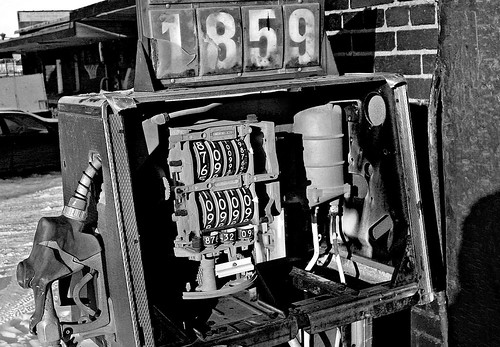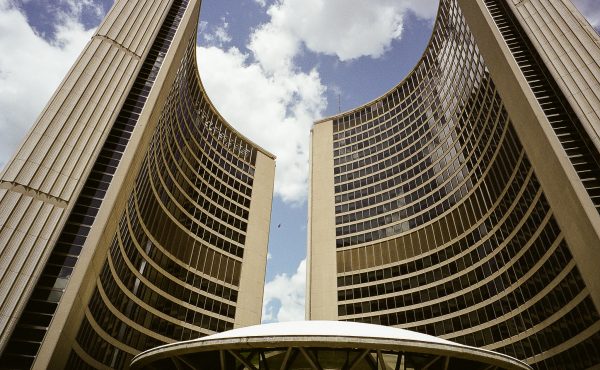
As we put the finishing touches on the upcoming issue of Spacing (which focuses on the role of the car in the city), we are discovering more and more articles documenting how our neighbours to the south are dealing with their looming financial downturn. Today, a CNN-Money article highlights a number of interesting trends from a recent national poll:
• Rising fuel prices have caused most Americans to cut back on their driving. Of the over 1,000 American adults surveyed in the poll conducted March 14-16, 64% said they have made some changes to their driving behavior as a result of higher gas prices, with 19% saying they have cut back on driving enough to have a major effect on their daily lives. And 5% say they have stopped driving altogether.
• If gasoline hits an average $4.50 a gallon Americans say they will reduce the miles they drive significantly enough to affect their daily lives.
• If gasoline hits an average of $8 a gallon, Americans said they would quit driving altogether.
photo by Chris Murphy


15 comments
Americans say these things but I always wonder if they will DO these things.
The only true evidence though that I can find is that the mid-range size RV sales are declining as documented in NYT. Travel outside of the US is dropping as well but ATV sales continue to rise.
The US sure loves to drive and I suspect that people will give up a lot before they stop driving.
C’mon $8/gallon gasoline! There is hope yet!
Random observation:
This weekend I was in New Jersey. Gas was (equivalent to) $0.80/L CDN there, and when I crossed the border into Canada it was $1.09/L here.
I agree with Scott’s comments.
With a sample of only 1000 people, aren’t those numbers devoid of any validity?
Actually, 1000 people is the standard size for surveys, and this one probably has a margin of error of less than 5%.
higher oil prices please! but we’ve all enjoyed lots of benefits in work and play from copious cheap energy.
oh, and recognizing that there are troubles with cars is not a new phenomena, even here in Caronto Ontcario
Means nothing. Canada has >$4/gallon gas for a long, long time, and the only difference in behaviour has been slightly higher use of transit (and even that could be chalked up to lower average incomes and fewer highways).
I wouldn’t expect to see any major lifestyle changes here in the US. Smaller cars, smaller engines, sure, but you’re not going to reformat the auto-dependent land use of the entire country overnight.
For example, if Canada has averaged a 90 cent dollar over the past few years and averaged gas prices of $1/L during that time, you get:
$1 Cdn per L = $3.785 Cdn per US Gal = $4.20 US/Gal
In Europe they are paying something like 1.50 Euro per liter. That translates to something like $2.75 CDN a liter, more than double what we pay here. People there still drive, the only difference in Europe are smaller cars, more transit and no sprawl. If they pay in the US what they pay in Europe they would not stop driving, they would just have a harder time to adapt. I just want to mention Denmark, one of the few places in the world that never forgot the energy crisis of the 70’s. Unlike Canada and many other places in the world, they kept building their economy to become less fossil fuel dependant, now they are laughing their way to the bank with and extremely low energy consumption to productivity ratio.
One thing to note when comparing European prices is that gasoline there is 95 octane and super is 98. Compare to the lower end 87-94 you get in North America.
And if it does hit $8.00 a gallon are they going to walk the 20 miles to work?
A great frustration of being a “public transit advocate” is that we hear much hand-wringing about what higher energy prices will do, but never quite get around to improving transit to the point that it’s really an option for most of the long-haul drivers.
People in the 905 and the outer 416 can legitimately claim that transit really isn’t an alternative because there isn’t enough of it when and where they need it to be attractive, no matter what the cost of fuel for their cars.
The lead time on major transit improvements means that any sudden rise in fuel costs cannot easily translate into political support for big changes in transit that could be implemented quickly. This could well mean that transit would be seen as unable to rise to the challenge while the motoring public adapts to the new price regime for fuel.
Ed makes an important point — people really can’t stop driving to work, as public transit isn’t a great alternative where most Americans live.
What they can do is stop going out on evenings and weekends. I’m always amazed how in many American cities (maybe the 905 is this way too), traffic in the middle of Saturday and Sunday is extremely heavy. When a long drive is your only choice if you want to go to a restaurant, movie, or store, cutting back on driving means cutting back on everything. And that’s a major adjustment — both individually, and for the economy.
To emphasize Matt L’s point, I have a friend who lives near Dorset. She drives to Bracebridge every few weeks to get sushi. That’s something like a 50-60 minute drive. Or, for a downtowner, it the equivalent of driving to Hamilton. Its these people who will have a very hard time if the oil crash comes.
I don’t mean to be so shameless, but look for Shawn Micallef’s article in the upcoming issue of Spacing if this topic is of interest. Its a great piece that tries to grapple with the looming change in lifestyle that peak oil could bring to the auto-reliant family on the edges of the suburbs.
When a long drive is your only choice if you want to go to a restaurant, movie, or store, cutting back on driving means cutting back on everything.
In other words, urban planning matters … !
Maybe thats what we need: a “cutting back on everything.”
The economy would hit the pits, but the market would adapt and we’d all be (somewhat) sustainable.